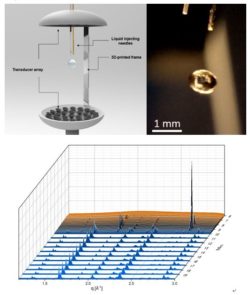Crystallization in confinement- Levitator system
Droplet-based systems are of great interest for studying nucleation, where the majority of small droplets are impurity-free. Acoustic levitation offers a straightforward means of generating single suspended droplets that offer clean environments and which are readily combined with in situ techniques of analysis (Fig. 1). By studying the in-situ formation of crystalline systems in a droplet, for example by X-rays synchrotron techniques, we therefore have a unique opportunity for understanding nucleation processes.
We are studying potassium nitrate using an acoustic levitator as this system offers the perfect combination of being highly soluble and presents itself in three different polymorphs (a- KNO3, b-KNO3 and g-KNO3). Our preliminary results using synchrotron Wide Angle X-ray Scattering (WAXS) show that crystallisation of different polymorphs can be triggered by slow evaporation of the droplet, increasing the supersaturation. Crystallisation of the metastable b-KNO3 is achieved at 6 min (at the lower regime of supersaturation) over the evaporation of the soluble KNO3 in the droplet (Fig. 1c). This polymorph remains for few minutes before disappearing, meanwhile the most common a- KNO3 appears remaining stable for the most of the supersaturated regime studied.

Figure 1: (a) Experimental setup of the acoustic levitator; (b) Captured image of the levitated KNO3 aqueous solution droplet. (c) Time-resolved wide angle X-ray Scattering data during the last 14 minutes of reaction.
